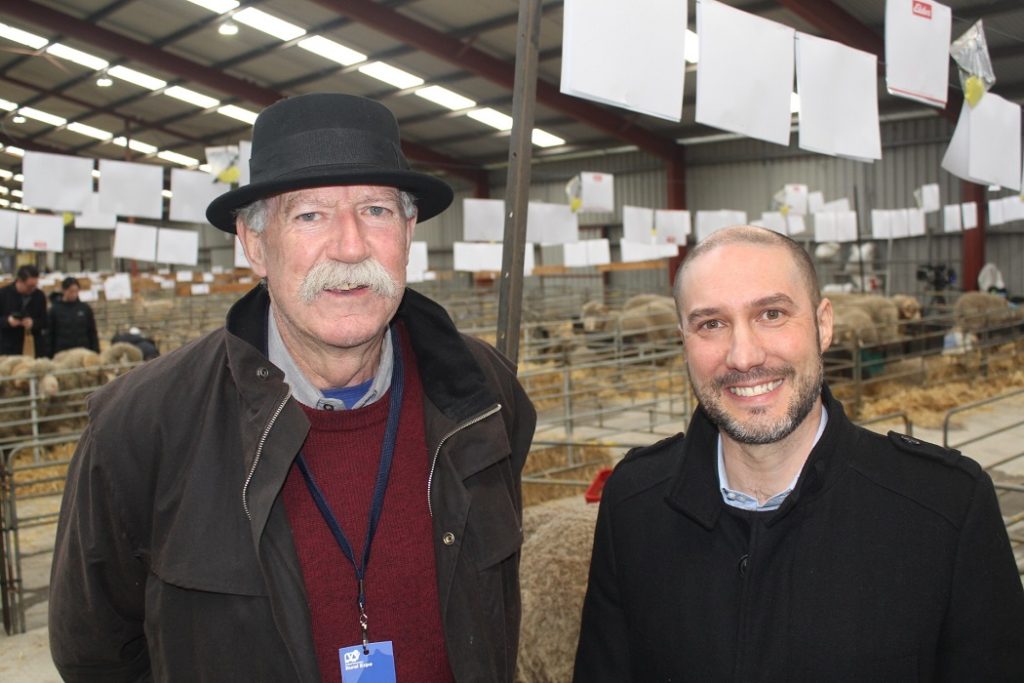
Hamilton wool and beef producer Michael Blake, left, with Agriculture Victoria chief executive officer Matt Lowe at the Sheepvention Rural Expo.
AUSTRALIA’S sheep, cattle and goat producers have been advised to get their stock independently valued to ensure compensation is paid in the event of a Foot and Mouth Disease or other emergency animal disease incursion.
Foot and Mouth Disease is not in Australia, but Hamilton district wool grower and beef producer Michael Blake said livestock producers could be faced with the destruction of their stock with no compensation if an incursion occurred and they did not have a prior valuation.
Mr Blake and his wife Cathy’s farm, Bally Glunin Park, has been operating under a biosecurity plan since 2001 and he has helped develop industry standards in biosecurity, animal welfare, sustainability, quality assurance and occupational health and safety.
Mr Blake has also done real-time FMD training in Nepal through the United Nation’s Food and Agriculture Organization.
Although the current AUSVETPLAN and its accompanying documents are under review, Mr Blake said there are things livestock producers can do to avoid minimise disappointment and the financial impact should they be caught in a disease outbreak and face the destruction of their livestock.
This included having accredited valuations on all livestock and wool on hand, and of other items such as fodder, fencing, fencing equipment and buildings that livestock might be in contact with.
“That would be the first thing I would do – get your livestock valued with your agent – don’t leave it to the last minute.
“Farmers should have an inventory of their stock, identifying ages, classes, sex and whether they are stud or commercial animals,” he said.
“Have your agent put current values against each stock category – an AuctionsPlus accredited agent would be the preferred valuer.
“If you don’t any valuations there is a small paragraph in there that says the value of livestock is the value of the day,” Mr Blake said.
“If you’ve got a valuation document you can argue that is the value or price, but if you don’t have a valuation they can determine that the value is zero, because once you have Foot and Mouth Disease, the value of the livestock is zero.”
Mr Blake said according to the AUSVETPLAN livestock owners may be considered ineligible for compensation if they fail to report a suspect emergency animal disease, or within an appropriate timeframe.
Version 5 of the AUSVETPLAN’s operational manual for valuation and compensation contains several clauses covering various situations, but producers should also be aware that state and territory legislation determines the process that owners should follow to claim compensation for animals and property destroyed during an EAD response.
According to version 5, the value of livestock or property is calculated as the farmgate value on the basis of a sale at the location when it was destroyed or died of disease. No allowance is made for loss of profit, loss occasioned by breach of contract, loss of production or any other consequential loss.
Commercial livestock values are based on an average of published Meat & Livestock Australia National Livestock Reporting System prices from two saleyards closest to the affected area. Stud sheep will only be considered as stud sheep if they are registered with a breed society.
Wool value is determined by the most recent Australian Wool Exchange market report on the AWEX website.
Mr Blake said farmers should also have a biosecurity plan with map and identified pit sites, taking into consideration access, visibility and ability to replant with trees.

HAVE YOUR SAY